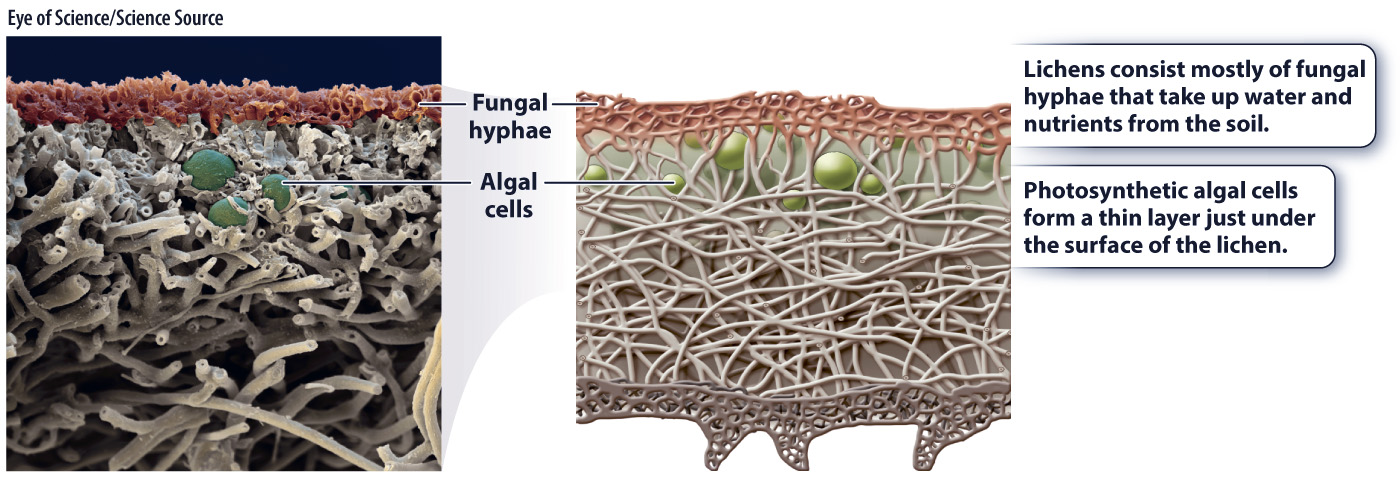Lichens are symbioses between a fungus and a green alga or a cyanobacterium.
Lichens are familiar sights in many environments, often forming colorful growths on rocks or tree trunks (Fig. 34.8). Lichens look, function, and even reproduce as single organisms, but they are actually stable associations between a fungus and a photosynthetic microorganism, usually a green alga but sometimes a cyanobacterium. Nearly 15% of all known fungal species grow as lichens.

The dual nature of lichens was first proposed by a Swiss botanist, Simon Schwendener, in 1867, but his hypothesis found little favor at the time. The existence of a composite “organism” challenged the idea that life could be divided into discrete categories such as animals and plants and raised the question of how an association of distinct species could function as an integrated whole. Given what we now understand about the widespread nature of mutualisms, the opposition to Schwendener’s proposal may seem surprising. Yet it was only in 1939, when Eugen Thomas showed that lichens could be separated into their individual parts and then reassembled, that their dual nature became widely accepted.
Lichens consist mostly of fungal hyphae, with the photosynthetic algae or cyanobacteria forming a thin layer just under the surface (Fig. 34.9). The hyphae anchor the lichen to a rock or tree, aid in the uptake and retention of water and nutrients, and produce chemicals that protect against excess light and herbivorous animals. In turn, the photosynthetic partners provide a source of reduced carbon, such as carbohydrates. Cyanobacteria living in lichens are capable of nitrogen fixation (Chapter 26) and thus can use atmospheric N2 as a source of nitrogen. The two partners exchange nutrients through fungal hyphae that tightly encircle or even penetrate the walls of the photosynthetic cells. As a result, lichens are able to thrive where neither partner could exist on its own.

It remains an open question whether either partner can exist independently in nature. In cases where the fungal partner can be grown in the laboratory in culture, it produces a relatively undifferentiated hyphal mass. Thus, while the bulk of the lichen structure comes from the fungus, chemical signals from the photosynthetic partner influence the form and shape of the fungus.
Surprisingly, these associations are not species specific. There are approximately 13,500 known lichens, but only about 100 participating photosynthetic species. This means that different lichens can have the same algae or cyanobacteria. Conversely, a given fungal partner may associate with more than one photosynthetic species without affecting the lichen’s outward form. Because of the intimate association between lichen morphology and fungal species, the lichen and fungus are assigned the same scientific name.
Lichens spread asexually by fragmentation or through the formation of dispersal units consisting of a single photosynthetic cell surrounded by hyphae. Sexual reproduction, at least by the fungi, is common, and the photosynthetic cells reproduce asexually by mitotic cell division. Whether sexual or asexual reproduction is more important in allowing lichens to establish in new habitats is not known.
Lichens are remarkable for their ability to grow on the surfaces of rocks and tree trunks. They are among the first colonizers of lava flows and the barren land left after glacial retreat. In these habitats, lichens obtain nutrients from rainfall or by secreting organic acids that help release some nutrients from even rocky surfaces. Not surprisingly, lichens in these harsh environments grow slowly. Some lichens grow on soil, for example reindeer “moss,” which grows in the Arctic tundra and is eaten by caribou. Reindeer moss is thought to compete successfully for space by secreting chemicals that hinder the growth of plants.
Given their small size and exposure to the environment, lichens must be able to tolerate drying out from time to time. All lichens have a high tolerance for desiccation, and can tolerate wide fluctuations in temperature and light. In contrast, lichens are quite sensitive to air pollution, particularly sulfur dioxide (SO2). For this reason, lichen growth is sometimes used as an indicator of industrial pollution.